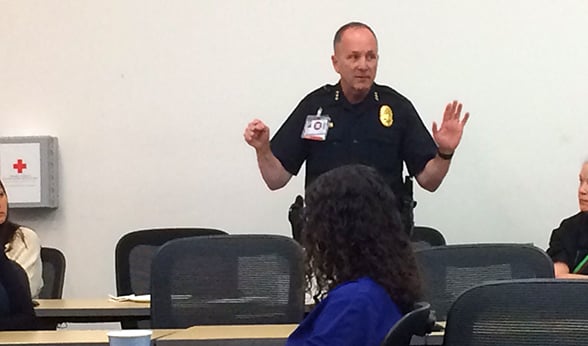As first responders described key ways people can stay safe on campus, especially in the event of an active harmer, CU Anschutz Police Chief Randy Repola addressed the elephant in the room: last week’s shooting at the STEM School in Highlands Ranch.
“It’s heartbreaking to watch what’s gone on again in Colorado, but I applaud your willingness to listen to this presentation,” he told a group of about 30 in a classroom in Education 2. “Some of this stuff sounds a bit extreme, and I hope you never need it, but you might find how it applies to even a very simple encounter you might have at work or at home.”
‘We’re not going to wait’
The lunch-hour talk, "When Presented with a Deadly Threat," covered how to prepare for possible threats, recognize potential threats and various options of actions during a threat. Also, the first responders offered general safety tips and described the actions people can expect from law enforcement as they arrive on the scene of an emergency.

CU Anschutz Police Chief Randy Repola makes a point during the active harmer presentation on May 13.
Joining Repola were University Police colleagues Detective Neil Stark, Officer Chris Withrow and Cory Garcia, emergency preparedness coordinator.
Stark said law enforcement officers learned much from the Columbine High School massacre in 1999 on how to respond to active harmer situations. “Police officers are now trained to just go to the threat and stop it. We’re not going to wait outside.”
He added, “You can see how fast the STEM School shooting was put under wraps – quite quickly – because the officers went in.”
Ways to stay safe
The presenters highlighted measures taken to improve security at CU Anschutz:
- The classroom security project, which has upgraded security in all classrooms in the Education buildings and one of the Research buildings. Equipped rooms have at least two panic buttons, a strobe light, severe bleeding control kit, electronic door locks and opaque film and reinforced windows.
- The campus community should program key numbers into their cell phones: 303-724-4444 for University Police and 303-724-4999 for Emergency Management; and bookmark the websites www.cuanschutz.edu/police and www.ucdenver.edu/alertsinfo
- All CU Anschutz students, faculty and staff are automatically registered to receive emergency alerts to their university-issued email addresses.
- Students, faculty and staff may register their personal cell phone number (as “cellular”) to receive emergency alerts by text. To register, go to cuanschutz.edu/police/alerts/emergency-alert , click the “Text Alerts” drop down in the menu and follow the directions.
- In the event of an emergency, university-owned desktop computers, laptops and tablets connected to the university domain will receive a “pop-up” alert.
- To stay connected via social media, follow @CUAnschutzAlert on Twitter and “like” @CUDenverPoliceDepartment on Facebook.
- Enroll in the Bleeding Control classes offered at least once a semester at CU Anschutz.
Get the ‘Safe Zone’ app
They also recommended that all members of the campus community add the free “Safe Zone” app to their phones. The app shares your phone’s location with the campus’s response team, helping responders find you quickly in the event of an emergency. It allows the user to make a one-touch emergency alert, First Aid alert and a help call.
SAFETY TIPS |
|
The police representatives also showed the FBI’s “Run. Hide. Fight” video on surviving an active shooter incident.
Things students, faculty and staff should do on a daily basis:
- Get to know your surroundings by taking a different stairwell, hallway or other alternate route to your workplace. Also be aware of your surroundings by avoiding use of earphones.
- Always wear your campus badge and politely question people who appear in your work area without one.
The presenters also explained the conceal-carry weapons policy that applies to CU Anschutz. In general, they advised campus community members to check with the HR department, your supervisor and specific weapons policies and procedures in your workplace location.
CARE, FaST teams
The first responders also covered the CARE (Campus Assessment, Response & Evaluation) and FaST (Faculty and Staff assessment) teams. CARE is a behavior assessment and referral resource for students, while FaST – 303-315-0182 or email FacultyStaff.Assessment@ucdenver.edu – is a similar resource for faculty and staff.
Repola said there is no typical profile that applies to a shooter or other harmer, but it’s often discovered post-event that the harmer gave indications of escalation or planning before the tragedy. “There is no such thing as a false alarm, and the CARE team and FaST team treat those as confidential (reports),” he said. “The idea is early intervention – get the person the help they need and protect the community.”
When something doesn’t seem right, Stark said, “trust your gut. Call us and let us check it out. Your gut is usually right.”




